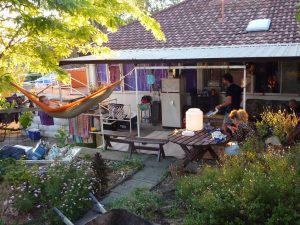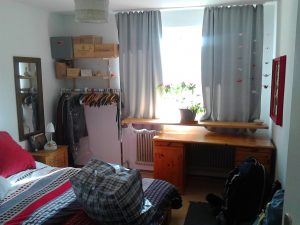Like many people, we lived in sharehouses during our 20s and generally had good experiences. We were pleasantly surprised to learn about groups of renters setting up long term sharehousing with the aim of living frugally, using less energy and water and growing substantial amounts of produce.
This is by no means exhaustive, but we’ve thrown in some of our ideas based on what worked for us during our collective 8 years in sharehouses and other successful sharehouses that we’ve personally seen or have been documented online.
Advantages of sharehousing
- Significantly cheaper renting costs (usually 50-80% less).
- Sharing of main furniture and appliances reducing the cost of purchase and repair.
- Lower heating and cooling costs per person.
- A much smaller housing environmental footprint compared to non-share housing.
- Can use shared labour to make tasks more manageable (e.g. growing food, cleaning, shopping, etc.)
- Great for having more socialising opportunities at home.
- Increased property security as there’s less opportunities for thieves to enter an empty house.
- Increased security for hard times as there’s smaller bills to pay and the possibility of negotiating support in a time of unemployment or injury.
- Can also provide an opportunity for people who are aging or living with a disability to maintain independence whilst feeling more secure in the presence of other people.

Smoothing over disadvantages: Finding the right house
- The best potential houses for sharehousing have the opportunity for housemates to socialise when they want to and retreat to indoor/outdoor private spaces when they want some alone time [1].
- Even small bedrooms can double as a private living space during the day when normal/roll up futon beds are used.
- In countries like Germany where house and apartment walls are solid and tenants can drill into them without landlord permission, it would be possible to use a murphy bed to free up space during the day [2].
- It’s possible to negotiate a longer than 12 month lease with a landlord if you are planning to make energy and food production retrofits to a property (see below).
- Know what you will and won’t accept in your living space. There’s (almost) no right or wrong here, but it’s better to be upfront straight away then to have problems down the track [3].
Preventing and resolving non-violent conflict
- Don’t be put off by mistakes but learn from them. Living in a shared arrangement is like any other skill that takes time to develop.
- Have an agreement at the start so there’s shared expectations around cleanliness, noise, how bills are paid, if cooking will be shared, protocol for housemates deciding to leave, etc.
- Have a method for dealing with conflict if it arises. Even in the most ideal sharehouse it’s nigh on impossible not to accidentally step on someone’s toes at some point. Here’s a useful guide here [4].
- Interviewing potential housemates is an important time to establish household norms, expectations and to see how interviewees deal with conflict.
- Use your common sense; as an example, be mindful of other housemates when having friends around and ask housemates first if you want to make a big change to the household (e.g. girlfriend/boyfriend moving in, taking on a pet, friends staying over long term).

Examples and resources
- The Sharehouse Case Study on retrosuburbia.com offers a good template on how to establish a long term sharehouse that has rental costs of $100 per person per week in Melbourne, produces food and has low energy and water use per person [5].
- As seen on the ABC Australia website, this group of 6 retirees have lived together for 11 years in a co-ownership arrangement. This could also be a co-renting option for retirees, especially as an alternative to a retirement home [6].
- Here is an example of a two person sharehouse that has enabled two people with intellectual disabilities to enjoy the freedom of independent living [7].
- The New South Wales based website, sharehousing.org has excellent information regarding the nitty gritty and legalities of running a sharehouse [8].
Obviously, setting up and living in a sharehouse requires some more consideration than a non-sharehouse but there are benefits including much lower living expenses and environmental impacts, more contact with people and greater autonomy for the elderly and people with disabilities.
Further Reading:
[1] As an example, we lived in a newly built two bedroom house that had two levels with large bedrooms. The bedroom up top had its own ensuite and a landing at the top of the stairs that would be ideal for a private chill out zone.
Two people or couples could rent a place like this, have enough private space indoors and outdoors when they want some alone time, a bathroom for each single person or couple and a generous shared living space and kitchen for a cost of $235 per week per single person/couple, cutting the cost of renting in half.
[2] A murphy bed is a bed that folds up against the wall to free up floor space during non-sleeping hours.
[3] As an example, you might appreciate a quiet living space or don’t want pets in the house. If a potential housemate likes to make noise or wants an indoor pet, it’s better to know upfront that living together is probably not a good idea.
[4] https://sharehousing.org/how-to-deal-with-non-violent-conflict/[5] 168 litres per person per day may not seem that low but for a house growing a lot of fruit and vegetables, this is a low amount of water usage:
https://retrosuburbia.com/case-studies/sharehouse-case-study/
[6] https://www.abc.net.au/life/the-experience-of-retiring-into-a-share-house/11076624 [7] https://www.abc.net.au/life/share-housing-when-you-have-a-disability/11076792 [8] https://sharehousing.org/